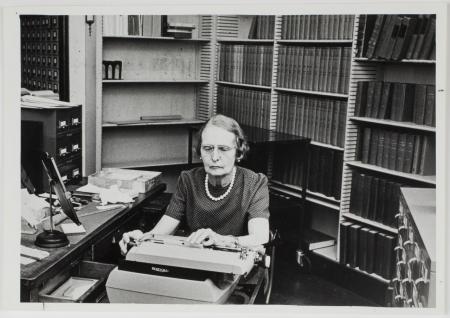Since Isaiah Thomas’s research for his ambitious The History of Printing in America (1810), the Society has held the largest set of data on the early printing trade in what is now the United States. Starting in 1927, Avis Clarke, AAS’s first trained cataloger, compiled a card catalog that came to be known as the Printers’ File during her 43 year tenure here. For many decades, these twenty-five drawers of cards could only be accessed in our reading room, a resource that became known as the Printers’ File. The term “printers” here is somewhat misleading, as the cards detail the work of 6,145 printers, publishers, editors, binders, papermakers, and others involved in the printing trade through 1820. Culled from newspapers, local histories, biographies, and reference books, the information on these cards is a vital set of data for the early American printing trade, but that is not all that it is. Mini-biographies or prosopographies of these people’s lives, the cards contain information about their time before and after they joined the trade—their humble beginnings as farmers before they moved to the big city, their stint in military engagements ranging from King Philip’s War to the Revolutionary War to the War of 1812, their work with charity, their time in prison, their marriages, their fortunes, and their follies. In short, the cards chronicle the lives of these people as they moved in and out of the printing trade, and they therefore provide evidence of the ways in which the work of printing permeated quotidian life in colonial America and the early Republic.
Consulting the Printers' File and the North American Imprints Program (NAIP)
We encourage researchers to confirm information listed on cards through the use of sources listed on the “authority cards” in the file as well as recent bibliographical and digital sources that were not available to Clarke when she retired in 1970. In fact, no new cards nor information were added to the file after Clarke’s retirement; instead, such information was updated and added in our contributions to both the Library of Congress’s Name Authority File and the North American Imprints Program (NAIP). The NAIP catalog contains over 40,000 records descriptive of 17th- and 18th- century imprints, and records the locations of more than 120,000 extant copies. This catalog is a part of our General Catalog, and so our catalog offers the most comprehensive listing of pre1801 United States imprints. A name search in our catalog will therefore render the most exhaustive list possible of pre1801 imprints associated with a person in the Printers’ File. NAIP work is ongoing in the cataloging of 19th-century imprints, so imprints associated with those working in the books trades post1801 will be comprehensive, but may not be exhaustive. NAIP does not cover newspapers however, so for information about those involved in the newspaper production trades, see Clarence Brigham’s “Index of Printers” at the back of his History and Bibliography of American Newspapers, 1690-1820 (1947).
The Printers’ File Online
AAS has worked on transforming data contained in the Printers’ File into a linked open data environment. Based on the cards, AAS contributions to the Library of Congress’s Name Authority File, and the NAIP records, the Printers' File Online is an effort to augment the types of queries our data can answer, to link our information to related data sets, and to allow greater access to a resource that is currently only available in our reading room.
In recent years, AAS staff reorganized, reordered, and in short, “digitized” this information so that it can be accessed as Linked Open Data. The printers' information has already been scanned, entered as data, and transformed into BIBFRAME, the library standard for Linked Open Data. In contrast to a siloed database, the data we created from the digitization of the Printers’ File was intended to be shared and expanded. Although the data is unindexed and therefore difficult to search, it can be found in spreadsheet and JSON formats in AAS's GitHub. The project as it currently exists on BIBFRAME can be found here.
Please contact jgarcia [at] mwa.org (John J. Garcia, director of scholarly programs and partnerships,) with questions about the Printers' File cards as well as the Printers' File Online.
